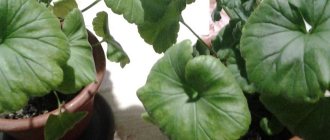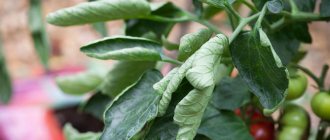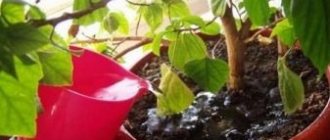Related Posts
Preparing the apartmentUltrasound for bedbugs
- Dry rot of potatoes
Plant diseases Why do cyclamen leaves turn yellow and curl? Many gardeners love cyclamen for its beauty and tenderness. But, like any other plant, it is prone to various diseases and is susceptible to insect attacks. Most diseases can be eliminated on your own; you can also protect the flower from insect attacks. And if this beauty’s leaves suddenly begin to curl and turn yellow, you should pay attention to the correct care of the flower, because cyclamen is very demanding to care for.
Why may leaves turn yellow?
Cyclamen is valued not only for its delicate and beautiful flowers, but also for the fact that the plant actively blooms in the autumn-winter period, when other flowers go into retirement.
It’s nice to look at this miracle in winter. But the flower is very demanding to care for, which is worth remembering for every gardener who decides to grow a handsome flower in his home.
Cyclamen turns yellow: what to do?
Cyclamen is an amazing, beautiful indoor plant. This explains its popularity among gardeners. In addition, delicate inflorescences bloom in late autumn and delight with their flowering until spring.
Achieving such long flowering is not at all easy. Cyclamen requires careful attention.
Often gardeners, especially beginners, are faced with the following problem: cyclamens turn yellow, damaged leaves fall off, and flowers wither.
In order to understand the reason for this phenomenon, it is necessary to understand the biological characteristics of this unusual plant. Cyclamen is a tuberous perennial flower. Its height, depending on the variety, can reach 35 cm.
Succulent leaves with an original color are located on dark red petioles. A plant tuber is a bulb with only one growth point. This structure of cyclamen makes it very “vulnerable”.
At the slightest damage to the bulb, the flower experiences stress, signs of disease and wilting appear. For this reason, cyclamen leaves turn yellow and fall off. If the tuber is severely damaged, complete death of the plant is possible.
Damage to the bulb
The flower belongs to the perennial family and grows from a small bulb. Germination occurs only at one point, and if the bulb is damaged during replanting, the plant may become sick, turn yellow and even die.
During the growth period, many rosettes are formed on the bulb, which participate in the formation of inflorescences and leaves. But it often happens that the plant begins to wither, become sick, and its leaves turn yellow and curl even with a healthy bulb. In this case, the reason should be sought elsewhere.
Common diseases
Cyclamen diseases occur with changes in the appearance of plants. Fusarium can cause yellowing of foliage. In this case, the change in the sheet begins, as a rule, from its upper part. The cause of this disease is specific fungi. The danger of this disease is that microbes can damage the internal structures of the plant. At the same time, the diseased plant begins to wither. If you do not start treating cyclamen in time, then fungi can damage its root apparatus. In such a situation, it will be extremely difficult to cure the flower.
Excessive moisture of the soil substrate is a fairly common cause of rot. Moreover, it can have a different color. The danger of this pathology is that severe damage to the root system occurs. In such a situation, full growth of cyclamen is impossible. If there is a lot of rot, then, unfortunately, it is not always possible to save the plant.
In this case, experts recommend urgently isolating the diseased flower, which will reduce the risk of infection of other plants.
Reduced room temperature and dampness are the reasons leading to the appearance of gray rot on the plant. The appearance of this disease is caused by damage to the root apparatus of the flower by fungi. Even a novice gardener can identify this disease. To do this, you need to carefully examine the leaves and flowers of cyclamen. The presence of a gray wet coating on the leaves, the death of peduncles and severe falling of buds are signs of this disease.
Damage to tubers
At home, only two types of plants are most often bred - Persian and European. But this process has its own difficulties. Most often, gardeners are faced with yellowing leaves of a completely healthy plant. Before you begin to eliminate this problem, it is worth understanding how to choose the right healthy flower in the store.
Before purchasing, you need to pay attention to the tubers. They must be smooth and without damage. If rot is detected on the tuber, then you should refuse to purchase such a plant. Healthy cyclamen has smooth tubers and fresh, juicy leaves.
Limp and withered foliage may indicate that the flower is sick with something. And the optimal time to buy a plant is considered to be autumn, when buds have already formed on it or flowers have opened.
Diseases and pests
Cyclamen can be affected by various diseases, but they can be divided into two types:
- Various rots of non-infectious origin . This happens due to improper care. Incorrect soil, too much watering and low temperatures lead to the roots or root collar starting to rot. You can try to save the plant. You can simply change the conditions and stop watering, or do something more radical: take out a lump of earth, dry it, clean the root, spray it with a solution of potassium permanganate, and plant it in clean soil.
- Fungal infections . First, the leaves turn yellow, curl, and then rot. Plaque may be present. It is necessary to treat the soil and plant with fungicides. Such unpleasant things happen due to improper care. The fungus thrives in an acidic, humid environment.
It is possible for some pests to settle in a pot with cyclamen:
- Aphid . A wingless insect about 2 mm in length. Most often it is green, but gray, black and orange individuals are also found. They often live on the back side of the leaf, where they actively suck the juice out of it. The leaves become deformed, curl and dry out (read about what to do if cyclamen dries out here). Rapid reproduction of aphids can lead to the death of the entire plant.
- Thrips . A spindle-shaped, light-colored insect about 2 mm long. Thrips is very mobile, thanks to which it quickly invades other plants. It can be easily seen with the naked eye. Thrips also leaves silvery marks in the form of drips. But the greatest danger comes from thrips larvae. Signs of thrips infection are deformation of the leaves, they first turn white, then turn brown and fall off.
- Cyclamen mite . Very small yellowish insects, which can only be seen in large crowds. It looks like dust on the inside of a leaf. The sign is deformation of the leaves along the edges. In severe cases, flowers wilt and shoots become deformed.
Read more about cyclamen diseases here, and here you will find information about pests.
Errors in care
In most cases, the cause of yellowing of cyclamen leaves is improper care at home. But here too there are some peculiarities. If only the leaves have turned yellow, but the inflorescences remain just as fresh and healthy, then you just need to adjust the temperature in the room. Cyclamen does not tolerate heat; the maximum air temperature for it should be seventeen degrees.
No less often, the flower suffers from a lack of moisture and direct sunlight, which scorch the leaves. If cyclamen constantly stands in a dry and shaded place, it stops producing inflorescences. Therefore, it is important to water the flower in time and feed it during the flowering period.
Cyclamen leaves may turn yellow for a number of other reasons. These include rotting of inflorescences and leaves, which occurs as a result of improper watering of the flower. It should be watered often, but not abundantly, otherwise there is a high probability of insects appearing.
It is strictly forbidden to pour water on the tubers, because this can lead to rot on them. Under no circumstances should you water the sprouting part of the flower, this will lead to its rotting.
Cyclamen in questions and answers
At first, beginning flower growers have many questions about growing this plant. What to do with a store-bought copy? How to replant it? How to care for cyclamen? Find answers to these and other questions in the article.
We bought cyclamen. What's next?
Purchased cyclamens must undergo a period of adaptation to new conditions. Since they were raised in a greenhouse with high humidity, moving to an apartment is a lot of stress for them. In such cases, I spray them with Epin twice a week. I do this at night or in the bathroom (Epin decomposes in the light).
You also need to check the cyclamen for pests . If they are detected, treat with appropriate medications.
You also need to check the tuber . It should be hard to the touch. If this is the case, and the cyclamen has dropped all its leaves, then you need to put it for forced rest in a cool place, not necessarily bright, for example, under a bath.
If the tuber is soft and rotten, you can try to cut out the rotten places, treat them with Fundazol, sprinkle them with crushed coal, dry them and plant them in fresh soil.
When is the best time to replant a plant?
If the cyclamen blooms and feels normal, you don’t need to replant it until the end of flowering, just feed it regularly and be careful with watering. I reload the purchased cyclamens in 4-5 weeks, after adaptation.
The pot for cyclamen should be small, so that from the tuber to the edge of the pot there is no more than 3-4 cm. soil for flowering plants with weak acidity, add baking powder (perlite, vermiculite, soaked coco soil).
At the bottom I put a layer of 1-2 cm of expanded clay and several pieces of charcoal. An important point is that when replanting (transferring), you must not destroy the lump of earth.
How to care for cyclamen seedlings?
As soon as the cyclamen seeds germinate, I place them in the brightest place on the windowsill, preferably cool (ideally 15-17ºC).
In winter, seedlings can withstand some direct sun, but in spring and summer shading is required. I water the babies as the soil dries, without flooding.
While the nodule is small and the root system is not developed, I water from above, but over time I switch to watering from the pan.
If the nodules rise above the ground, then it is advisable to bury them in the ground. This promotes leaf growth. Now you can add soil.
What are the basic rules for caring for cyclamens?
Yellowed leaves must be removed; this is a source of rot and infections. In this case, the leaf must be twisted, as it were, and not torn off, so that remnants of the petiole, especially softened ones, do not remain on the tuber.
Cyclamen does not like waterlogging or severe drying. I water only from the tray. In the summer, if the plant does not go dormant, I water it every day. Sometimes I use ice cubes instead of water. In winter I water it every other day or two. But if the cyclamen, for example, is on a glassed-in loggia at a temperature of 12-17ºC, watering can be once every 5-7 days!
I have a rule: before watering, I always test the soil with my finger.
I don’t spray , as moisture getting into the growing point can lead to rotting. You can humidify the air above the plants using a fine spray bottle. I also place containers of water between the plants - a very simple and effective method of increasing humidity.
When I spray with Epin or treat with pesticides, I try to minimize the ingress of moisture onto the tuber!
Why do flower stalks grow short?
This phenomenon often occurs in cyclamens during home flowering. Sometimes low peduncles are a varietal characteristic. But more often the reason lies in conditions that are not comfortable for the plant or in a lack of nutrition. Feed your pet with fertilizers for flowering plants (for example, Kemira-Lux).
Cyclamen leaves curl. What should I do?
Cyclamen has several reasons for leaf curl. The first is dry air and high temperature. The second is the presence of pests. Periodically inspect the underside of the sheet through a magnifying glass. The third is fungal or bacterial infection of the plant.
The cause may be waterlogging or contaminated soil. How to proceed? First, I would remove all diseased leaves and treat them with appropriate drugs (Fundazol, Fitosporin, Topaz, Oxychom, Trichodermin, etc.). And then I would transplant the cyclamen into fresh soil.
If the infection is not too severe, there is a chance to save the flower. For prevention, it is advisable to sterilize or steam the soil before planting, water it once a month with a weak pink solution of potassium permanganate, which well suppresses bacterial infection and partially fungal infection.
And one more thing - you should not get carried away with fertilizing with a high nitrogen content, this reduces the plant’s immunity.
Source: https://indoor.usadbaonline.ru/ru/2014mar/bloom/1272/
Insect infestation
If the leaves on your cyclamen begin to curl or become deformed, mites may be the cause. If a flower is affected by pests, then you should wash its leaves with an insecticidal agent as often as possible.
As an alternative, insecticidal pet soap can be used. The plant also needs to be regularly sprayed with special solutions - Fitoverm or Agravertin. These products are odorless and work well against pests.
How to resuscitate at home?
The main program for plant resuscitation is to improve care.
In most cases, it is improper watering that becomes the root cause of cyclamen disease. The flower loves moisture very much, but waterlogging is destructive for it. Water should not get on the flower itself; it should be watered along the edge of the flowerpot. Read how to save flooded cyclamen here. To keep the air around the plant moist, place a tray with wet pebbles or peat next to it. In detailed instructions we will tell you what to do if the plant disappears.
detailed instructions
The first thing to do is replant the plant
Carefully remove the tuber from the pot and inspect it for rotting - the ability to revive the flower depends on how and how far the rot has spread. If you find rotten parts, take a sharp knife and remove them to healthy tissue
To prevent these places from rotting again when replanting, they need to be treated. To do this, in 2 tbsp. l of water, dilute 1 drop of Prvikur and moisten the cut areas. After this, we transfer the tuber to a warm, dry, well-ventilated place and leave for 24 hours so that the rotting process stops. After a day, you need to check the cyclamen; if there are still wet spots on the tuber, then leave it for another 24 hours.
During this time, we prepare the soil - carry out the disinfection process, for this you need to pour it into a special container and heat it well in the oven. Some gardeners advise placing the soil in the freezer for 24 hours, but it is worth knowing that not all diseases can be excluded in this way, for example, spores of parasitic fungi can withstand very low temperatures while remaining viable. If the soil is bought in a store, then there is no need to process it, since it goes through a disinfection process at the time of packaging. Before planting, the pot must be washed and rinsed with a solution of potassium permanganate. Plant cyclamen and place it in a dark place for 3 days, with very moderate watering. If during this time the green leaves have not begun to turn yellow, the treatment of the tuber and replanting were carried out correctly, you can move the pot to the place usual for cyclamen.
Pests cause irreparable damage to the flower, and they need to be dealt with correctly.
You can remove any insects in the following ways:
- Insecticidal soap, which is dissolved in water at the rate of 50 grams per 4 liters of water. A soap solution helps well in the fight against mites and aphids. It is enough to take a cotton swab dipped in the solution and treat the leaves of the plant on all sides.
- Fitoverm - this drug has proven itself in the fight against many pests; its positive quality is the absence of an unpleasant odor and absolute safety for humans and pets. To treat a plant affected by a mite, an ampoule with a chemical is diluted in 0.5 liters of water. If there are thrips, you need to take 2 ampoules of 2 ml for the same amount of liquid. Spraying is carried out 2 times at intervals of a week.
- Argavertin is a universal drug that destroys all insect pests. 1 ampoule is diluted into half a liter of water and sprayed on the plant. Usually one treatment is enough, but for prevention you need to repeat the process after 2 days.
Rules for caring for cyclamen
Cyclamen is a very fastidious plant, and if the rules of caring for it are not followed, cyclamen quickly withers, dries, and its tubers rot. A sick plant is also more quickly susceptible to pest attacks.
The main parameters that should be adjusted in the room where cyclamen is located are temperature, lighting, humidity and direct sunlight. Thus, not every room is suitable for such a flower.
Let's find out why cyclamen leaves curl and how to deal with it?
Cyclamen is one of the favorite types of plants, popular among people who want to create home comfort with the help of fresh flowers. Its flowering surprises with its colorfulness, and caring for the flower is simple - the main thing is to prevent emerging problems in time.
In the article we will look at the features of caring for cyclamen, the reasons for the folding of leaves and ways to counteract this.
Features of care
Lovers of indoor flowers speak differently about cyclamen: some believe that the flower is unpretentious, while others claim that it is a capricious plant. In fact, cyclamen needs sunlight, but does not tolerate direct sunlight .
In addition, the flower must be kept at low temperatures - in winter it should be no higher than 14 ° C, in summer - up to 25 ° C. When watering, you should not overwater the flower, and the main thing is not to wet the buds with tubers, as this can cause them to rot. You will learn how to save a flooded flower in this article.
Cyclamen blooms in the cold season, from late autumn to March. It is during this period that it is advisable not to overheat the flower. The dormant period of the plant is not expressed in the European cyclamen, but in the Persian cyclamen, expressive signs of this period appear:
- stops blooming;
- leaves turn yellow;
- Cracks may appear on the tuber.
Leaf blades curl up: normal or pathological?
Leaf curling, especially severe leaf curling, should be a cause for concern . On the one hand, this may be a signal about the beginning of a dormant period, but if for some unknown reason the leaves suddenly curl up along with the flowers, and at the same time the flower produces many new young leaves, the matter is different.
Some cyclamen diseases can manifest themselves in curling and yellowing of leaves, so it is very important to notice the problem in time and not confuse the disease with the beginning of a dormant period.
Check out the photo of cyclamen with leaves curling down:
Possible reasons
Why do cyclamen leaves curl? Let's consider common reasons, discarding the option of switching to rest mode.
Nutrition
Since the flower needs feeding, it is important to feed it correctly . If the fertilizing contains a large amount of nitrogen, the plant’s immunity is reduced. In addition, if the flower lacks nutrition, the leaves grow small, and the cyclamen does not bloom.
Cyclamen needs to be fed constantly; for this it is better to use complex mineral fertilizers. Fertilization is especially recommended during the flowering period.
Air temperature
Cyclamen loves cool rooms; under no circumstances should it be placed near radiators or other means of heating - the flower will immediately react to high temperatures. During the flowering period, it is better to put the plant in a room where it is cool: the ideal temperature for it will be about 14°C. Due to the fact that it is almost impossible to maintain such a temperature in summer, it is necessary to take care in advance of transferring the flower or cooling it.
At the same time, you cannot leave the flower in a draft - the plant does not tolerate constant movement of cold air . It is sufficient to ventilate the cool room well.
Pot size
When replanting cyclamen, you need to remember that the flower does not need a lot of extra space, so it is important to choose a pot that is not spacious. The size of the pot should depend on the age of the flower - a diameter of up to 8 cm is acceptable for an age of 1-1.5 years, and a diameter of up to 15 cm is acceptable for a flower about 3 years old.
Pests
Like any plant, cyclamen can be harmed by insects:
- Aphid. Cyclamen affects more often than other pests and often completely covers the leaves.
- Thrips. They appear under conditions of elevated temperature and lack of moisture in the air.
- Cyclamen mite. May attack leaves at high air humidity. Outwardly it looks like settled dust.
To identify pests, you need to carefully examine the leaves on both sides. Quite often they “hide” on the back of the leaves.
We wrote in more detail about cyclamen pests in another material.
The soil
The process of watering the plant is very important: after replanting, you need to water the flower little by little, and only when the owner sees new leaves can you gradually increase the volume of watering to normal and start feeding cyclamen.
During watering, you need to make sure that moisture does not get on the tuber. If this happens, you need to remove the moisture with a dry cloth. Under no circumstances should the soil be over-moistened - this can lead to rotting of the tubers .
Also, the soil may be contaminated initially. In order to check this, you need to remove the flower from the pot and carefully examine the tuber. If there are any integrity problems, soft spots or dents on it, such pieces must be thoroughly cleaned from the ground and carefully cut off. It is better to dry the cut areas a little and treat them with crushed activated carbon. Then transplant into another pot.
What to do if you get sick?
The procedure for dealing with a flower disease depends only on the reason for the curling of the leaves. It is important to first make sure that the flower does not go into dormancy mode - in this case, the leaves turn yellow and curl gradually.
- Malnutrition. If the flower has not been fed for a long time and the reason is a lack of nutrition, you can purchase a universal mineral fertilizer and feed it with cyclamen.
- Heat. If the cause of leaf curling is elevated temperature, you need to move the plant to a cooler room. It is important to monitor the temperature, and you can use a regular room thermometer for this.
- Big pot. When a flower has a lot of space in a pot, it is necessary to transplant it into a new pot, which is approximately the size of the diameter of the tuber.
- The appearance of pests. If pests are detected, you need to isolate the flower from other indoor plants, and be sure to identify the type of pest:
- Any plant is susceptible to diseases and pests. This is possible due to improper care and non-compliance with preventive measures. How can you save cyclamen from death and what can you do if your flower’s peduncles dry up or it withers and the leaves dry out? You can restore beauty and health by reading our articles on this topic.
Prevention
To protect a flower from diseases, it is enough to monitor the environment, especially the air temperature in the room, prevent sunlight from falling on the leaves, and follow the rules of watering.
If a decision has been made to replant due to the fact that the flower no longer fits in the old pot, after changing the “housing” you need to monitor the condition of the leaves and tubers. Cyclamen should be watered carefully, at the very edge of the pot . You can also use a tray - pour water into it, and place the flower so that the water covers at least half of the tuber. After some time, you need to take out the cyclamen and let the water drain well. Find out what to do if you have flooded a flower here.
Periodic spraying of insecticides will help protect against pests . In conclusion, it should be noted that with proper care, such problems with the flower will not arise.
Ventilate the room regularly - this will avoid waterlogging and rotting. Compliance with basic safety measures will allow you to enjoy beautiful flowering throughout the winter and ensure the good condition of the flower, which can be propagated.
If you find an error, please select a piece of text and press Ctrl+Enter.
Temperature
It often happens that the plant blooms very quickly and sheds its leaves. The reason for this is dry air and high temperature in the room.
Rapid flowering and shedding of leaves can also be associated with excessively low temperatures and dryness. For example, if the flower is in a draft. To cope with the problem, you need to feed the flower in time, provide air humidification and regular watering.
Cyclamen leaves wither
Why do cyclamen leaves wither? Leaves and buds wither if the cyclamen goes to rest, from an excess of moisture in the soil or from a lack of water. All problems with the photo are described in detail below.
Cyclamen leaves wither and turn yellow if the plant begins a dormant period . If cyclamen is put to rest, then its leaves wither gradually. This happens in early June, sometimes in mid-July, when the temperature in the room where the flower is located rises above +20 degrees. New leaves no longer grow, neither do buds. Old leaves begin to gradually wither and turn yellow. The plant is placed in a dark, cool place with good ventilation. You need to remember that for cyclamen that was recently purchased, the dormant period can begin at any time. The explanation is simple: the flower’s life rhythm may be disrupted, and therefore one should not be surprised if a new flower begins to gather for rest in the middle of winter.
If the leaves and flowers wither en masse, the cyclamen is sick .
Many new gardeners mistakenly assume that the plant has retired. But that's not true. Cyclamen prepares for dormancy gradually. If it suddenly drops its leaves, this indicates problems with the root system. It can rot from improper watering. Watering should be carried out only after the top layer of soil has dried. Top watering only. Bottom watering is not suitable here. There is a high probability of soaking the bottom layer of soil, which leads to rotting of the tuber. If a cyclamen tuber rots, it is removed from the soil and inspected. If it is slimy and the roots are flabby and brown, the flower cannot be saved. If the tuber is elastic and the roots are flabby, the latter are removed and the plant is allowed to rest. Cyclamen leaves wither if the plant lacks moisture. The flower is watered after the top layer of soil has dried. Timely watering is important if the plant is kept at temperatures above +20 degrees. In this case, you cannot wait until the soil in the pot dries completely. Cyclamen grows and develops well with moderate soil moisture in the pot and air.
Lighting
The lighting should also be special. The location of the cyclamen should be well lit. The light should be diffused and quite bright. You can use special LED lamps for plants.
However, direct sunlight should be avoided, especially in summer. At lunchtime, the plant still needs to be shaded, although in the morning and evening direct sunlight will be beneficial for cyclamen.
Cyclamen leaves turned yellow
The leaves turn yellow and wither if the cyclamen is attacked by pests, or if it does not have enough sunlight at a high temperature. The reason may be low air humidity.
If cyclamen grows in shade or partial shade and its leaves turn yellow, then the cause is a lack of sunlight. Experts recommend placing the flower in spring and autumn on windows that are oriented to the east. In winter, south-facing windows work well. Bright, diffused lighting is an important condition for growing cyclamen. However, direct sunlight can cause burns on the plant. It is also recommended to provide cyclamen with artificial lighting using a fluorescent lamp or ice lamp.
The leaves turn yellow and wither if the cyclamen is in a stuffy room where there is poor air circulation. Carbon monoxide and tobacco smoke can harm the flower. The plant needs a regular supply of fresh air. However, placing it under an open window in winter is prohibited, since cold air currents can destroy the flower. The leaves also turn yellow and the flowers wither if the cyclamen is kept in too warm a room. The optimal temperature for it is +12. +17 degrees. If the leaves of the cyclamen turned yellow after flowering in the period from March to May and this happened slowly, the tuber remained elastic and healthy, the cyclamen went to rest.
Very often, inexperienced gardeners buy a weak or diseased plant in a store.
In most cases, it does not last long at home. Immediately after flowering it dies. The only way to save a purchased, diseased flower is to send it to rest, but again only if the tuber and root system of the plant remain intact. Healthy cyclamen produces abundant flowers and lots of green leaves. If the leaves of a cyclamen turn yellow, then the flower is too hot; for example, it can be kept in winter at a temperature of +20 degrees and above . At the same time, the room has a low level of air humidity. Comfortable conditions for keeping the plant +12. +17 degrees. If the temperature is higher, the cyclamen sheds its leaves and buds. To fix everything, you need to move the flower to a cool room, increase the air humidity there and organize artificial lighting.
Watering
During the growing season, special attention should be paid to watering the plant. The best way to do this is to use the immersion method. But if a flower is watered from a watering can, then the water should be poured as close to the edge of the pot as possible.
Stagnation of liquid in the pot should be avoided. And the water for irrigation must first be settled so that it does not cause rotting processes in the roots. It is better to cut off damaged leaves that are already curling and dried leaves with scissors. Just do this very carefully so as not to damage the growth area.
Prevention
It is quite difficult to treat diseased cyclamens. Experts note that preventive measures help to significantly reduce the risk of flowers being damaged by various pests. It is recommended to follow them immediately after purchasing cyclamen. For good growth, the flower requires optimal air temperature, as well as moderate watering. There are a few tips worth paying attention to.
- To detect any damage to the flower in time, it must be inspected regularly. In this case, special attention should be paid to foliage. Leaves must be inspected not only from the top side, but also from the bottom. If necessary, you can use a magnifying glass. This will allow you to detect even the most minor changes, which means that treatment can be started on time if necessary.
- Before planting cyclamen in the substrate, it is recommended to treat the soil. For this purpose, it is sterilized or steamed. Some experts recommend treating the substrate with a weak solution of potassium permanganate.
- In order for cyclamen to grow well, the nutrient substrate in which it is located should not be fertilized too much. Thus, the abuse of nitrogen fertilizers can cause damage to the root apparatus of the flower, which means it can lead to slower growth.
- Choosing the optimal size pot is very important. These decorative flowers generally grow well in medium-sized containers. Experts recommend choosing a pot for this beautiful flower in such a way that the distance between its corm and the wall of the pot is approximately 2.5–3 cm. It is better to place the pot with the plant away from heating appliances.
You can learn how to properly transplant cyclamen by watching the video below.
«>
Air
The air in the room where the flower stands must be very humid. To achieve this, just place the pot with the plant on a tray with damp pebbles or peat. Cyclamen will only be happy about this. But you should not spray the plant itself. This can cause the leaves to rot. Periodically you need to humidify the air around the flower using a fine spray in a spray bottle.
Cyclamen requires:
- Cool temperature;
- Regular watering;
- Humid air.
The plant requires special care immediately after flowering. All flowers must be cut down to the bulb. Watering should be reduced, and fertilizing and fertilizing should be eliminated altogether. During this period, yellowed and dried leaves are not cut off, but are twisted together with the cuttings.
If the leaves curl
Curling leaves is a signal that the plant is not feeling well. If they curl downward, it means that something has happened that has plunged him into a state of illness or stress. It is the curling and wilting of leaves that are the first sign of a variety of problems. In order to help cyclamen, it is necessary to analyze the situation and find the root cause of such a sign. Why do the leaves curl? Let's look at the possible reasons for this problem:
Nutrition . With the beginning of the active period, cyclamen needs to be fertilized. You can use any complex mineral fertilizer for indoor plants. One feeding every 20 days is enough. They begin to feed a week after the appearance of young shoots, or 3 weeks after purchasing cyclamen in the store. Therefore, if your cyclamen was actively growing and was not fed, the reason may be a lack of fertilizer.
- Air . Cyclamen does not tolerate dirty atmospheres. Dust, tobacco smoke, splashing air fresheners and other foreign impurities can put the flower in a state of stress. In addition, air temperature is important; cyclamen prefers cool air in the range from 12 to 16 degrees. Any deviations have a bad effect on his well-being. The air around the plant must also be moist; the area around the flower must be sprayed daily. You cannot spray cyclamen!
- Pot . As with most tuberous plants, a small container is needed for cyclamen. The volume of soil should not be much greater than the volume of the tuber. In a pot that is too large, undeveloped soil becomes acidic. In an acidic environment, the absorption of nutrition and moisture by the roots is poor, and pathogenic microorganisms develop. Which can manifest itself as leaf curling.
- The soil . After the purchase, some people strive to quickly transplant the flower into fertile soil, without bothering too much about what kind of soil it should be. Cyclamen does not like clay, high acidity and high organic content. Light soils with a neutral reaction based on leaf soil are suitable for it.
Leaf soil is soil from the tree trunks; it is, in fact, rotted leaves. Mix 3 parts of leaf soil and one part each of sand, vermiculite, humus and peat. The soil you prepare yourself must either be kept in the freezer for 2 days or fried in the oven. The easiest option is to buy ready-made soil mixture for cyclamen in the store.
- Rest period . Perhaps your plant is completely ready to go dormant, but you continue to feed and fertilize it. Such care can result in the death of the cyclamen. The dormant period usually begins after flowering ends.
- Watering . Insufficient watering, when the soil in the pot does not get wet to the roots, or, on the contrary, very wet soil, can lead to disastrous consequences. The soil should have time to dry out between waterings. An adult plant requires more extensive and rare watering, while a young plant requires frequent, but little by little watering. It is better to water using the tray method. You can find out how to save flooded cyclamen here.
Care in spring and summer
Closer to spring, the plant will go into a dormant state, this will be indicated by the completely dried remaining leaves. At this time, the plant should be laid on its side, watering should be stopped completely and it should be put in a cool place until July. In summer, in mid-July, the flower should be placed in a shaded place and the soil should be moistened regularly.
As soon as the first leaves appear, it can be transplanted into another pot. After replanting, you need to ensure that pests do not settle on the flower, otherwise the plant may die without having time to bloom.
How to proceed?
So, how can you save a flooded cyclamen and what to do if you have over-watered the plant? The success of measures to save cyclamen is determined by the degree of rotting of the tuber.
- If the rotten part is small, there is a chance of recovery. Urgent transplant required:
- Prepare a pot with a hole in the bottom, as well as drainage and soil. The soil can be purchased at a specialty store or prepared yourself. A breathable substrate made of coarse-fiber peat is required. For the soil mixture, you should combine leaf soil, humus, peat and sand in equal proportions. On a note. If there is no new soil, you can use the old one. First make sure that it does not smell of rot or mold and dry it.
- Disinfect the soil and the pot if it is not new. Calcine the substrate in an oven preheated to 80 degrees for 30 minutes.
- Remove the flooded plant from the pot.
- Carefully free the roots from any remaining soil.
- Inspect them.
- If the roots are hard and elastic, overwatering the plant has not yet led to irreversible consequences.
- Place the plant on pre-spread newspapers.
- Wet the root system and let it dry.
- Place a 5 cm layer of drainage at the bottom of the pot. You can use expanded clay, clay shards, tiny polystyrene foam, coal, vermiculite.
- Place fresh, slightly moistened soil on the drainage so that after replanting the third part of the tuber is above the surface.
- To stimulate, lightly dust the root system with root.
- Plant the plant in the center of the pot and add a little more substrate. In summer, place expanded clay on the soil surface to prevent overheating.
- If some roots become soft and brown, the process of root rot has already begun. To save cyclamen you need:
- Rinse the root system.
- Trim rotten roots with scissors or a sharp knife to healthy, dense tissue.
- Dry the root system.
- Sprinkle the cut with crushed activated carbon.
- Plant the plant in fresh or dried soil.
- Then proceed as described above.
- If all the roots are soft and brown, the plant cannot be saved. You can cut cuttings, treat them with root and try to root them in a greenhouse, for example, under a plastic bottle.
- If the tuber is rotten:
- The rotten part should be cut out to a healthy place.
- Dry slightly, treat with activated carbon powder.
- Plant in fresh cyclamen soil. The tuber should be half above ground level, the roots should not curl upward.
Note! Do not place a flooded plant in the sun - its roots will dry out.
You can find out more about how to revive cyclamen at home here.











